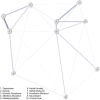Putting the Vicious Cycle to the Test: Evidence for the Cognitive Behavioral Model of Persistent Somatic Symptoms From an Online Study
- PMID: 38666664
- PMCID: PMC11462881
- DOI: 10.1097/PSY.0000000000001313
Putting the Vicious Cycle to the Test: Evidence for the Cognitive Behavioral Model of Persistent Somatic Symptoms From an Online Study
Abstract
Objective: In clinical practice, persistent somatic symptoms are regularly explained using a cognitive-behavioral model (CBM). In the CBM, predisposing, perpetuating, and precipitating factors are assumed to interact and to cause the onset and endurance of somatic symptoms. However, these models are rarely investigated in their entirety.
Methods: We conducted an online survey during the COVID-19 pandemic. A total of 2114 participants from the general German population completed questionnaires that measured different factors of the CBM. We used state negative affectivity and neuroticism as predisposing factors, fear of a COVID-19 infection as the precipitating factor, and somatic symptoms, misinterpretation of bodily symptoms, attention allocation to bodily symptoms, and health anxiety as perpetuating factors. Moreover, we added safety and avoidance behavior as end points to the model. We conducted a psychological network analysis to exploratively study the relationships between the model's different factors and tested the assumptions of the CBM by evaluating a structural equation model (SEM) that incorporated all factors of the model.
Results: Network analyses revealed clustering in our data: Health anxiety and different cognitive factors are closely related, whereas somatic symptoms and state negative affectivity are strongly associated. Our SEM showed adequate fit.
Conclusions: Our findings from an exploratory and a confirmatory approach give empirical support for the CBM, suggesting it as a suitable model to explain bodily symptoms in the general population and to possibly guide clinical practice. The network model additionally indicates the necessity to apply an individualized CBM for patients, depending on a preponderance of either persistent somatic symptoms or health concerns.
Copyright © 2024 The Author(s). Published by Wolters Kluwer Health, Inc. on behalf of the American Psychosomatic Society.
Figures


References
-
- Hiller W, Rief W, Brähler E. Somatization in the population: from mild bodily misperceptions to disabling symptoms. Soc Psychiatry Psychiatr Epidemiol 2006;41:704–12. - PubMed
-
- Voigt K, Nagel A, Meyer B, Langs G, Braukhaus C, Löwe B. Towards positive diagnostic criteria: a systematic review of somatoform disorder diagnoses and suggestions for future classification. J Psychosom Res 2010;68:403–14. - PubMed
-
- Van den Bergh O, Stegen K, van de Woestijne KP. Learning to have psychosomatic complaints: conditioning of respiratory behavior and somatic complaints in psychosomatic patients. Psychosom Med 1997;59:13–23. - PubMed
-
- Brown RJ. Medically unexplained symptoms: a new model. Psychiatry 2006;5:43–7.
-
- Brown RJ. Psychological mechanisms of medically unexplained symptoms: an integrative conceptual model. Psychol Bull 2004;130:793–812. - PubMed
MeSH terms
LinkOut - more resources
Full Text Sources
Medical

